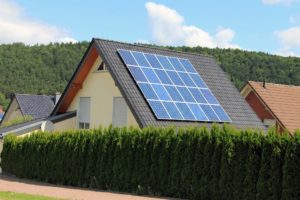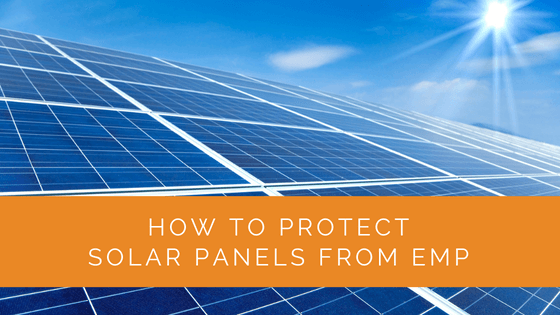Now is the time to make sustainable choices and use the best renewable power sources, such as solar energy. Making an eco-conscious decision to improve the environment and installing a solar power system is just a step forward in the right direction.
The next step is ensuring your solar power system runs efficiently, making your business or home self-sustainable. Protecting yourself from a potential solar flare, an EMP attack would be best.
Let’s look at what EMP means and how you can safeguard your solar panels from possible destruction caused by an electromagnetic blast.
Contents
- 1 Key Takeaways
- 2 What Is EMP or Solar Flare?
- 3 Can EMP or Solar Flare Damage the Solar Panel Systems?
- 4 Are Off-Grid Solar Panel Systems Immune to An EMP Attack?
- 5 Can Solar Panel Systems Survive an EMP Attack?
- 6 Can We Protect Our Solar Panel Systems from An EMP Attack?
- 7 Case Study: Solar Panel Protection
- 8 Expert Insights From Our Solar Panel Installers About Protecting Solar Panels from EMP
- 9 Experience Solar Excellence with Us!
- 10 Final Words
Key Takeaways
- Solar panels and solar power systems can be vulnerable to damage from electromagnetic pulses (EMP), such as those caused by solar flares or nuclear detonations, primarily due to the long connecting wires and electronic components like charge controllers and inverters.
- Off-grid solar panel systems are less susceptible to EMP attacks, but connecting wires and diodes may still be affected, reducing system efficiency.
- Protecting solar panel systems from EMP attacks can be achieved through measures like constructing a Faraday cage, using EMP-hardened solar inverters, installing surge protectors, or opting for solar panel leases to mitigate financial losses in case of damage.
What Is EMP or Solar Flare?
When the sun’s surface erupts with massive energy production, making it one of the enormous explosions happening within our solar system, it’s termed a solar flare. There is another kind of eruption on the sun’s surface wherein the sun’s matter is released into space. It’s called Coronal Mass Ejection (CME).
On the other hand, EMP releases an electromagnetic pulse when a nuclear weapon detonates or lightning strikes. There are faint traces of this electromagnetic pulse or wave in the solar flares.
When this energy is exuded, it can destroy solar power systems, GPS, radios, communication systems, power grids, and many other electronic devices, especially ones with wires.

Can EMP or Solar Flare Damage the Solar Panel Systems?
While solar panels have no electronics fitted within their structure, long wires connect them with the entire solar power system.
So, these long wires play the role of a magnificent antenna that attracts the flare and damages the solar panel or panel systems after the occurrence of an EMP. Any solar power electronics will likely get killed for the same reason.
The charge controller and the solar inverters make for the prime component in any solar power system. They help convert solar power into usable energy.
Unfortunately, these elements are most susceptible to face disruption or damage from an EMP or solar flare.
Are Off-Grid Solar Panel Systems Immune to An EMP Attack?
An off-grid solar power system comprises a battery bank, a photovoltaic solar panel, and several other significant pieces. Since these components do not hold any circuitry, they are not prone to any direct harm caused by EMP.
That said, solar flares can cause damage to the connecting wires of the off-grid solar panel system since electricity runs through them. These wires attract the EMP signs, which might reduce the solar power system’s full functionality and efficiency.
Besides the connecting wires, the strings of diodes that facilitate the power transfer from the solar panel system to the battery bank might also be adversely affected.

Can Solar Panel Systems Survive an EMP Attack?
An EMP attack is not a very likely occurrence. Certainly not, unless a massive nuclear weapon is detonated in the Earth’s atmosphere.
This EMP attack will occur in three phases – E1, E2, and E3.
E1 is potentially the most damage-inducing pulse, wherein a big burst of gamma radiation will saturate the air within its range of up to 50,000 volts of electricity. This will happen in nanoseconds post the nuclear eruption.
E2 will act more like a cloud of lightning, which is slightly less harmful to the power grids since they have inner EMP protection against lightning. Although, E1 is likely to destroy anything that E2 could have saved.
E3 is more of a slow-moving electromagnetic pulse. It will produce geo-magnetic currents in the long line of electrical conductors. In simple terms, all the power lines and telephone wires will have a build-up of powerful charge, which will quickly zap all the electronics on their way.
All the precious grid substation equipment and power transformers will lose their electrical power in no time.
In these phases of an EMP attack, you best believe that it will disrupt everything that uses electronic circuitry. This includes all electronics in airplanes, cards, electric grids, and your residential solar system. This damage will likely be irreversible.
The report by the U.S. Government states that the sequence in which E1, E2, and E3 of an EMP attack occurs is significant. Each phase is likely to cause damage, but the harm created by the later phase can exponentially increase depending on the injury caused by the earlier phase.
In either case, fixing the electric system will take weeks or months to replace critical parts and slow the stabilization of the grid.
Additionally, if projected in the right direction, a coronal mass ejection (CME) could act like the E3 phase of an EMP attack. CME surprisingly happens often, except they rarely impact us.
The first recorded CME struck Earth in 1859, which led to electricity zapping in the telegraph system. It was the biggest CME hit. In 2012, a near-miss incident also happened, which could have cost a massive U.S. $2 trillion loss by putting out enormous transfers.
There was a 12% chance for a mega CME storm to hit Earth in 2020, but that did not happen. So far, we are in the safe!
Now, the main question arises…
Can We Protect Our Solar Panel Systems from An EMP Attack?
The installation costs of solar panels are, on average, around $16,000. As cost-saving and energy-intensive solar panel systems are, they require a reasonable budget for an overall setup.
In such a case, looking for reasonable methods to ensure your new solar panel installation is protected from possible EMP attacks makes sense.
Now, we know that connecting wires of the solar installer act as an antenna for the flares. The longer the cables, the larger the possibility of damage.
If your panels are not connected to any wire, they might not face any destruction. Similarly, your electronic devices, like solar inverters, computers, charge controllers, smartphones, etc., may not get damaged if switched off and unplugged.
But, for an extra layer, you can undertake the following methods of EMP protection:

Construct a Faraday Cage
A Faraday cage is quite a simple device that helps protect electronic devices from any possible electromagnetic radiation.
It looks like a box with a non-conductive frame, carefully wrapped in a metal mesh. This mesh conducts the EM radiation and electricity while protecting the essential components within the device from getting destroyed.
Any electronic put inside a Faraday cage will survive the dreadful impact of a nuclear EMP.
You can quickly build this cage yourself by following these steps:
- Take two galvanized sheets of metal that are larger than your solar panel system
- Put one sheet of metal at the top and another at the bottom of the panel
- Make sure to wrap all your wires with any conductive material like aluminum foil
- Then, connect your board
- Remember not to touch the metal sheets with your bare hands once the panel is connected.
- Additionally, it’s significant to adequately ground your panel system and the Faraday cage for solid protection.
Buy One EMP-Hardened Solar Inverter
A Faraday cage may help keep your solar panel system from getting zapped only if it’s not plugged in. Otherwise, the E3 pulse will still fry all the circuit boards.
Several solar companies know how to offer ample protection from an EMP attack.
One such utility company has invented a Sol-Ark solar inverter, which is EMP-hardened. The inverter is explicitly designed to prevent any possible EMP disruption due to the sun or a nuclear weapon.
It protects your solar panel system and offers you much-needed peace of mind. Come what may, your solar energy system will survive solar flare, EMP, or any other doomsday event, ensuring you’re never out of energy!
Get a Surge Protector
For most commercial devices and residential solar power systems, lighting arrestors and surge protectors offer excellent protection during an electricity outage.
They may also protect the devices from the impact of EMP. While a powerful solar flare can wipe out all electrical services, it won’t damage electronic devices like panel systems if plugged into the surge protector.
Nonetheless, you would have to run the devices on backup power sources.

Get Panels on A Solar Lease
Solar leases are not much protection against EMP, per se, but they will make solar panels more accessible to you without investing a considerable fund.
In case a solar flare or EMP attack happens, you won’t face a financial loss by getting your solar panel systems destroyed!
Case Study: Solar Panel Protection
Background
The Green family, residing in Savannah, Georgia, decided to install a solar power system to reduce their carbon footprint and harness renewable energy. Given the increasing concerns about EMP (Electromagnetic Pulse) threats and solar flares, they sought to protect their investment. They approached Solar Panels Network USA for expert advice on how to shield their solar setup from potential EMP damage.
Project Planning and Objectives
The primary objectives were to install a reliable solar power system and implement measures to protect it from EMP-related disruptions. The Green family wanted a solution that would ensure continuous energy supply even in the event of an EMP attack.
Installation and Costs
The proposed solution included a 6kW solar panel system with additional protective measures. The cost breakdown was as follows:
- Solar Panels: $12,000
- Installation: $3,500
- EMP-Hardened Inverter: $2,500
- Faraday Cage Construction: $1,500
- Surge Protectors: $500
- Permits and Inspections: $700
- Total Estimated Cost: $20,700
Financial Incentives:
- Federal Tax Credit (ITC): $6,210
- State Rebates: $1,500
- Adjusted Total Cost: $12,990
Installation Process
The installation was completed in four days, involving the following steps:
- Site Preparation: Ensuring optimal placement of panels on the south-facing roof.
- Panel Installation: Mounting 24 high-efficiency solar panels.
- EMP-Hardened Inverter: Installing an EMP-resistant inverter to protect against electromagnetic pulses.
- Faraday Cage: Constructing a Faraday cage around critical components to shield them from EMP waves.
- Surge Protectors: Installing surge protectors on all connections to guard against power surges.
- Inspection and Activation: Conducting a final inspection and activating the system.
Results and Benefits
The Green family’s solar power system now generates approximately 700 kWh per month, covering most of their energy needs and significantly reducing their reliance on the grid. The system’s protective measures ensure its durability against potential EMP threats.
Environmental and Financial Impact:
- Annual Savings: $1,800
- Payback Period: ~7 years
- Reduced CO2 Emissions: ~3 metric tons annually
- Enhanced Energy Security: The family experiences fewer worries about EMP threats and potential solar flare impacts.
Summary
The Green family’s experience in Savannah, Georgia, demonstrates the importance of protecting solar power systems from EMP threats. By integrating an EMP-hardened inverter, constructing a Faraday cage, and using surge protectors, they ensured their investment’s longevity and reliability. Solar Panels Network USA provided expert guidance, ensuring a smooth installation process and comprehensive protection. Savannah’s favorable conditions and proactive approach to renewable energy make it an exemplary location for such advancements. The Green family’s case highlights that with the right precautions, solar energy systems can be both efficient and resilient against potential disruptions.
Expert Insights From Our Solar Panel Installers About Protecting Solar Panels from EMP
Investing in EMP-hardened solar inverters is a crucial step to safeguard your solar power systems. These inverters are specifically designed to withstand electromagnetic pulses, ensuring that your energy setup remains functional even during an EMP event.
A Faraday cage can be an effective way to protect the electronic components of your solar system from EMP damage. By properly grounding and insulating your system, you can significantly reduce the risk of damage from solar flares or EMP attacks.
Surge protectors are a simple yet effective method to shield your solar power system from potential EMP-induced surges. Ensuring all your critical components are connected to surge protectors can help mitigate the risk of irreversible damage.
Experience Solar Excellence with Us!
Trust in Solar Panels Network USA, where our seasoned experts deliver top-quality solar solutions for homes and businesses nationwide. With a legacy of countless successful installations and a commitment to sustainable energy, we’re your reliable partner in the solar journey. Ready for a brighter, eco-friendly future? Call us now at (855) 427-0058 and harness the sun’s power!
Final Words
Solar flares or EMPs can cause considerable damage to your electronic devices, especially ones with wires. So, if your panels are not plugged in, they are more or less protected from the potential damage of the flare. On the other hand, if you connect them to the power system with long wires and power coursing through them, an EMP attack can destroy your entire system.
Thus, it’s essential to prepare for any tragic event like an EMP attack by taking steps that would protect your solar panels or grid system.
You can do this by building a Faraday cage. Alternatively, a surge protector might help, too. You can also buy an EMP-hardened solar inverter or invest in a solar lease instead of getting the panel system yourself.
These proactive steps will protect your power system from any disaster awaiting you!
About the Author
Solar Panels Network USA stands at the forefront of solar energy solutions, driven by a team of seasoned solar engineers and energy consultants. With over decades of experience in delivering high-quality solar installations and maintenance, we are committed to promoting sustainable energy through customer-centric, tailored solutions. Our articles reflect this commitment, crafted collaboratively by experts to provide accurate, up-to-date insights into solar technology, ensuring our readers are well-informed and empowered in their solar energy decisions.

